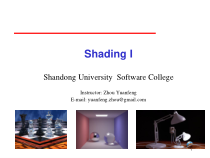 PPT
PPT
【文档说明】计算机图形学computer-graphics课件13.ppt,共(63)页,3.519 MB,由小橙橙上传
转载请保留链接:https://www.ichengzhen.cn/view-77498.html
以下为本文档部分文字说明:
1ShadingIShandongUniversitySoftwareCollegeInstructor:ZhouYuanfengE-mail:yuanfeng.zhou@gmail.com2Objectives•Le
arntoshadeobjectssotheirimagesappearthree-dimensional•Introducethetypesoflight-materialinteractions•Buildasimplereflectionmodel---thePhongmode
l---thatcanbeusedwithrealtimegraphicshardwareSimpleLightingmodelWithSpecularlightingGouraudshadingWire
framePolygonWhyweneedshading3WithshadowWithTexture4Whyweneedshading•SupposewebuildasceneusingmanypolygonsandcoloritwithglColor.Wegetsome
thinglike•Whichisthebest?5Shading•Whydoestheimageofarealspherelooklike•Light-materialinteractionscauseeachpointtohaveadifferentcolororshad
e•Needtoconsider-Lightsources-Materialproperties-Locationofviewer-SurfaceorientationWhy?6Scattering•LightstrikesA-Som
escattered-Someabsorbed•SomeofscatteredlightstrikesB-Somescattered-Someabsorbed•SomeofthisscatteredlightstrikesAandsoon7Rendering
Equation•Theinfinitescatteringandabsorptionoflightcanbedescribedbytherenderingequation-Cannotbesolvedingene
ralways-Raytracingisaspecialcaseforperfectlyreflectingsurfaces•Renderingequationisglobalandincludes-Shadows-Multiplescatteringfromobjecttoobject8
GlobalEffectstranslucentsurfaceshadowmultiplereflection9LocalvsGlobalRendering•Correctshadingrequiresaglobalcalculationinvolvingallobjectsandlightsou
rces-Incompatiblewithpipelinemodelwhichshadeseachpolygonindependently(localrendering)•However,incomputergraphics,especiallyrealt
imegraphics,wearehappyifthings“lookright”-Existmanytechniquesforapproximatingglobaleffects10Light-Mate
rialInteraction•Lightthatstrikesanobjectispartiallyabsorbedandpartiallyscattered(reflected)•Theamountreflecteddeterminesthecolorandbrightnessoftheobj
ect-Asurfaceappearsredunderwhitelightbecausetheredcomponentofthelightisreflectedandtherestisabsorbed•Thereflectedlightisscattered
inamannerthatdependsonthesmoothnessandorientationofthesurface11LightSourcesGenerallightsourcesaredifficulttoworkwithbecausewemustin
tegratelightcomingfromallpointsonthesourceLightcolor:I=[Ir,Ig,Ib],RGBmode,CMYmodeBGRYMC11112SimpleLightSources•P
ointsource-Modelwithpositionandcolor-Distantsource=infinitedistanceaway(parallel)-I(p0)=[Ir(p0),Ig(p0),Ib(p0)]SimpleLightSour
ces•Easytouse(incomputer)•Realisticispoor:•Imagecontrastishigh,somepartsarebrightandothersaredark;•Inrealworld,thelightswillbelar
ge.•Wecanaddambientlighttosolvethisproblem.13umbrapenumbraSimpleLightSources•Spotlight-Restrictlightfromidealpointsource14Whyusecosfunc
tion?SimpleLightSources•Infinitelight:Sunlight-Justknowthelightdirection;-Theintensityisconstant.•Ambientlight-Sameamountoflighte
verywhereinscene-Canmodelcontributionofmanysourcesandreflectingsurfaces15Ia=[Iar,Iag,Iab]thesamevalue
ateachpointonsurfaces16SurfaceTypes•Thesmootherasurface,themorereflectedlightisconcentratedinthedirectionaperfectmirro
rwouldreflectedthelight•AveryroughsurfacescatterslightinalldirectionssmoothsurfaceroughsurfaceSuchasmirrorsSuchasawalltra
nslucentsurfaceSuchaswater17PhongModel•Asimplemodelthatcanbecomputedrapidly•Hasthreecomponents-Diffuse-Specular-Ambient•Usesfourvec
tors-Tolightsource-Toviewer-Normal-Perfectreflector18AmbientLight•Ambientlightistheresultofmultipleinteraction
sbetween(large)lightsourcesandtheobjectsintheenvironment•Amountandcolordependonboththecolorofthelight(s)andthematerialpropertiesof
theobject•AddkaIatodiffuseandspeculartermsreflectioncoefintensityofambientlightaIpaIak=19DiffuseReflection•Anidealdiffusesurfaceis,atthemicroscop
iclevel,averyroughsurface.•Chalkisagoodapproximationtoanidealdiffusesurface.•Becauseofthemicroscopicvaria
tionsinthesurface,anincomingrayoflightisequallylikelytobereflectedinanydirectionoverthehemisphere.20LambertianSurface(朗伯面)•Perfectlydiffuserefle
ctor•Lightscatteredequallyinalldirections•Amountoflightreflectedisproportionaltotheverticalcomponentofincomingl
ight-reflectedlight~cosqi-cosqi=l·nifvectorsnormalized-Therearealsothreecoefficients,kr,kb,kgthatshowhowmuchofeachcolorcomponentisreflected,rela
tedwiththematerials21Lambert'sCosineLaw•Lambert'slawdetermineshowmuchoftheincidentlightenergyisreflected.•Rememberthattheamountofen
ergythatisreflectedinanyonedirectionisconstantinthismodel.Inotherwords,thereflectedintensityisindependentoftheviewingdirection.IpdIpdcosqqCABdIpdId
kcosq=:,,ddrdgdbkkkk:pdIincidentlightintensity22Illuminationeffects•Shadedusingadiffuse-reflectionmodel,fromlefttorightkd=0.4,0.55,0.77,
0.85,1.0.•Shadedusingaambientanddiffuse-reflectionmodel,Ia=Ilight=1.0,kd=0.4.Fromlefttorightka=0.0,0.15,0.30,0.45,0.6023SpecularSurfaces•Mostsurf
acesareneitheridealdiffusersnorperfectlyspecular(idealreflectors)•Smoothsurfacesshowspecularhighlightsduetoincominglightbeingreflectedindirect
ionsconcentratedclosetothedirectionofaperfectreflectionspecularhighlight24IdealReflector•Normalisdeterminedbylocalorientation•Angleofincidence=ang
leofrelection•Thethreevectorsmustbecoplanarr=2(l·n)n-lrlHowtocomputer2cosincosinlnliv25ModelingSpecularRelections•Phongproposedusin
gatermthatdroppedoffastheanglebetweentheviewerandtheidealreflectionincreasedfIr~ksIcosafshininesscoefa
bsorptioncoefincomingintensityreflectedintensitycos()frv26TheShininessCoefficient•Valuesofabetween100and200correspon
dtometals•Valuesbetween5and10givesurfacethatlooklikeplasticcosaff90-9027SpheresshadedusingphongilluminationmodelRefractlight•Snelllaw•
ηt,ηiaretherefractfactors2811(coscos)tiqqt=-lnRefractfactor2930DistanceTerms•Thelightfromapointsou
rcethatreachesasurfaceisinverselyproportionaltothesquareofthedistancebetweenthem•Wecanaddafactoroftheform1/(c1+c2dL+c3dL2)to
thediffuseandspecularterms•Theconstantandlineartermssoftentheeffectofthepointsource31Lightsourceattenuation(衰减)•I=Iaka+fattIlightkd(N.L)-fat
t=1/dL2-fatt=(1/min((c1+c2dL+c3dL2),1));Distance11.3751.752.1252.5C001.25.25.501032LightSources•InthePhongModel,weaddtheresultsfromeachlightsour
ce•Eachlightsourcehasseparatediffuse,specular,andambienttermstoallowformaximumflexibilityeventhoughthisformdoesnot
haveaphysicaljustification•Separatered,greenandbluecomponents•Hence,9coefficientsforeachpointsource-Idr,Idg,Idb,Isr,Isg,Is
b,Iar,Iag,Iab33MaterialProperties•Materialpropertiesmatchlightsourceproperties-Nineabsorbtioncoefficients•kdr,kdg,kdb,ksr
,ksg,ksb,kar,kag,kab-Shininesscoefficienta34AddinguptheComponentsForeachlightsourceandeachcolorcomponent,thePhongmodelcanb
ewritten(withoutthedistanceterms)asI=kdIdl·n+ksIs(v·r)a+kaIaForeachcolorcomponentweaddcontributionsfromallsourcesPhonglightmodel3536ModifiedPhongM
odel•ThespecularterminthePhongmodelisproblematicbecauseitrequiresthecalculationofanewreflectionvecto
randviewvectorforeachvertex•Blinnsuggestedanapproximationusingthehalfwayvector(分向量)thatismoreefficient37CalculatingthereflectionvectorR
=Ncosq+S=Ncosq+Ncosq-L=2N(N.L)-LCalculatingN.HinsteadofR.V,inwhichH=(L+V)/|L+V|2*b=a38Usingthehalfwayangle•Replace(v·r)aby(n·h)b•bisc
hosentomatchshineness•Notethathalfwayangleishalfofanglebetweenrandvifvectorsarecoplanar•ResultingmodelisknownasthemodifiedPhongorBli
nnlightingmodel-SpecifiedinOpenGLstandard39ExampleOnlydifferencesintheseteapotsaretheparametersinthemodifiedPhongmodel40Comp
utationofVectors•landvarespecifiedbytheapplication•Cancomputerrfromlandn•Problemisdeterminingn•Forsimplesurfaces,it
canbedeterminedbuthowwedeterminendiffersdependingonunderlyingrepresentationofsurface•OpenGLleavesdeterminationofnormaltoapplication-ExceptionforGL
UquadricsandBeziersurfaces(Chapter11)41PlaneNormals•Equationofplane:ax+by+cz+d=0•FromChapter4weknowth
atplaneisdeterminedbythreepointsp0,p2,p3ornormalnandp0•Normalcanbeobtainedbyn=(p2-p0)×(p1-p0)p1p0p242NormaltoSphere•Implicitfunctionf(x
,y.z)=0•Normalgivenbygradient•Spheref(p)=x2+y2+z2-1=0•n=[∂f/∂x,∂f/∂y,∂f/∂z]T=p43ParametricForm•Forsphere•Tangentplanedeterminedbyv
ectors•Normalgivenbycrossproductx=x(u,v)=cosusinvy=y(u,v)=cosucosvz=z(u,v)=sinu∂p/∂u=[∂x/∂u,∂y/∂u,∂z/∂u]T∂p/∂v=[∂x/∂v,∂y/∂v,
∂z/∂v]Tn=∂p/∂u×∂p/∂v44GeneralCase•Wecancomputeparametricnormalsforothersimplecases-Quadrics-Parametericpolynomialsurfaces•Beziersurfacepatc
hes(Chapter11)45PolygonalShading•Shadingcalculationsaredoneforeachvertex-Vertexcolorsbecomevertexshades•Bydefault,vertexshadesareinterpolated
acrossthepolygon:-glShadeModel(GL_SMOOTH);•IfweuseglShadeModel(GL_FLAT);thecoloratthefirstvertexwilldeterminetheshadeofthewholepolygon
Flatshading•Normalissameineachpolygon;•Infiniteviewer;•Infinitelight;•Forflatshading,weonlyneedcomputethecolorofonepointinthispolygon.4647Pol
ygonNormals•Polygonshaveasinglenormal-ShadesattheverticesascomputedbythePhongmodelcanbealmostsame-Ide
nticalforadistantviewer(default)orifthereisnospecularcomponent-Infiniteviewerandlight•Considermodelofsp
here•WantdifferentnormalateachvertexeventhoughthisconceptisnotquitecorrectmathematicallyCharacteristic•It’sba
dforpolygonapproximatesmoothsurface.Thecolorinpolygonsisdifferent.48Viewofhuman•Machband•Howtoavoidthisband?Weshouldusesmoothshadin
g.4950SmoothShading•Wecansetanewnormalateachvertex•Easyforspheremodel-Ifcenteredatoriginn=p•Nowsmoothshadingworks•Notesilhouet
teedge51MeshShading•Thepreviousexampleisnotgeneralbecauseweknewthenormalateachvertexanalytically•Forpolygonalmodels,Gouraudproposedweusethe
averageofthenormalsaroundameshvertexn=(n1+n2+n3+n4)/|n1+n2+n3+n4|Datastructureforpolygon•Searchadjacentpolygonsfore
achvertex.5253ShadingmodelsforPolygons54Twointerpolatedshading•Gouraudshading-Cheapbutgivespoorhighlights•Phongsha
ding-Slightlymoreexpensive,butgiveshighqualityhighlightsFlatGouraudPhone55565758GouraudV.S.PhongGouraudV.S.Phong5960Gourau
dandPhongShading•GouraudShading-Findaveragenormalateachvertex(vertexnormals)-ApplymodifiedPhongmodelateachver
tex-Interpolatevertexshadesacrosseachpolygon•Phongshading-Findvertexnormals-Interpolatevertexnormalsacrossedges-Interpolateedge
normalsacrosspolygon-ApplymodifiedPhongmodelateachfragment61UnrepresentativevertexnormalsSpheresubdivision
6263Comparison•Ifthepolygonmeshapproximatessurfaceswithahighcurvatures,PhongshadingmaylooksmoothwhileGouraudshadin
gmayshowedges•PhongshadingrequiresmuchmoreworkthanGouraudshading-Untilrecentlynotavailableinrealtimesystems-Nowca
nbedoneusingfragmentshaders(seeChapter9)•Bothneeddatastructurestorepresentmeshessowecanobtainvertexnormals
 辽公网安备 21102102000191号
辽公网安备 21102102000191号
 营业执照
营业执照